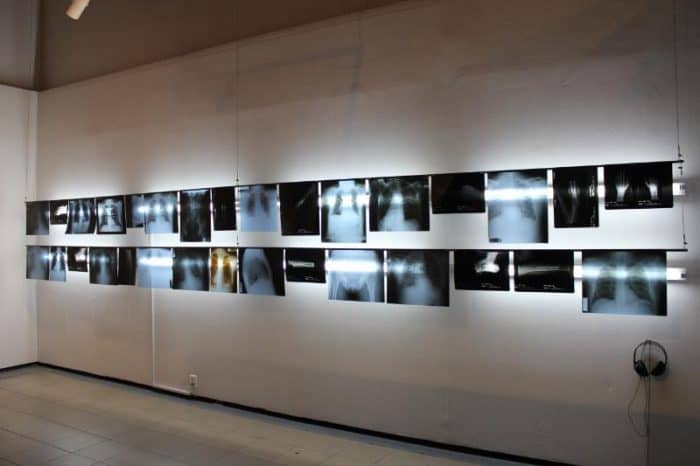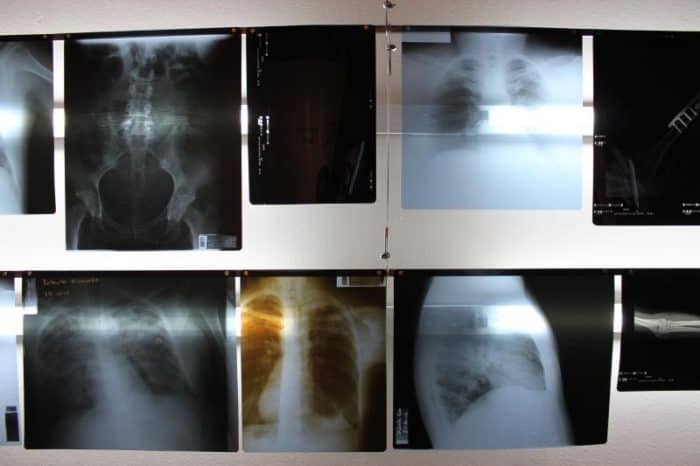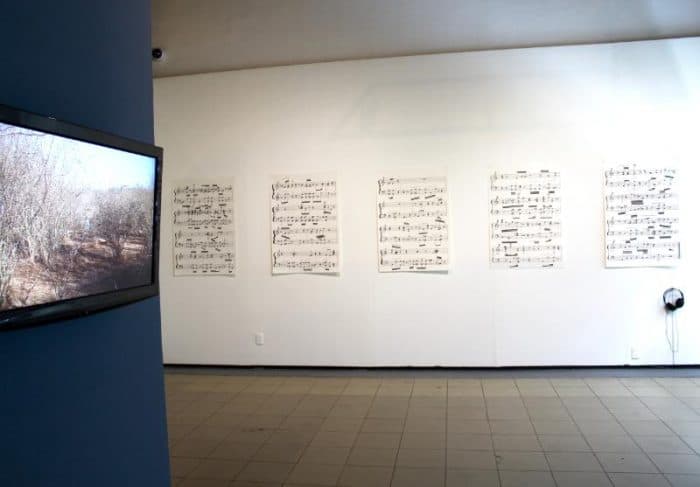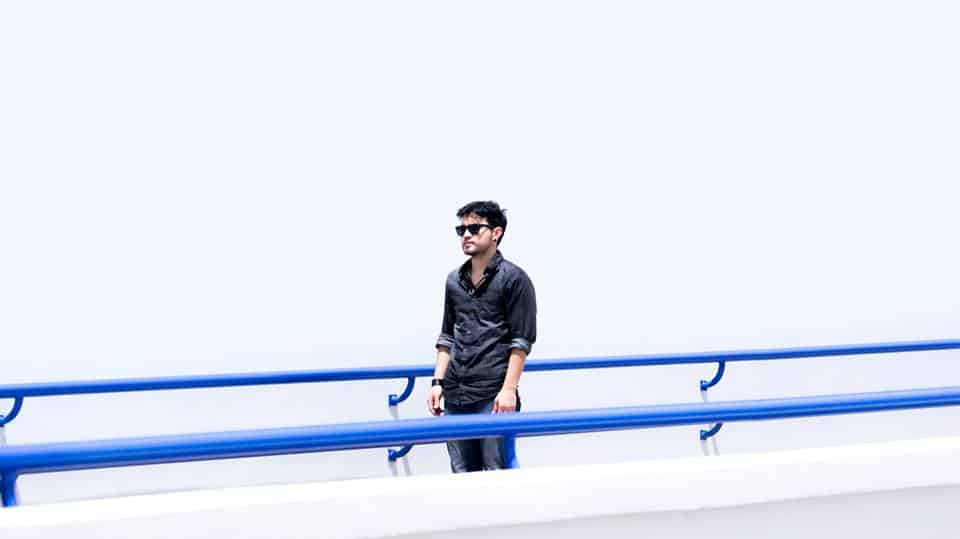Over the years, a number of writers, artists and filmmakers have told the stories of Central American migrants and the challenges they face. However, the latest project from Honduran artist Pável Aguilar focuses on migrants who have paid an unimaginable price: those who had to return to their homeland because of the loss of one of their extremities during their journey.
Such a fate is sadly common for migrants who fall or are pushed from the infamous train known as La Bestia (The Beast), atop which many migrants ride through Mexico to the U.S. border.
To create the collection Partidas y partituras (Departures and music scores), now on display at the Museum of Contemporary Art and Design (MADC) in San José, Aguilar worked with Honduras’s Center for the Care of Returned Migrants and Houston’s Philharmonic Orchestra. He interviewed Honduran migrants, then communicated thier stories using music, video and graphics.
Aguilar transformed one of the migrant’s words into audios waves and depicted them graphically as a musical score; he also included the X-rays of various migrants who suffered the loss of an extremity, broke a bone or had some sort of metal inserted in their bodies.
“I think it’s necessary to speak, dialogue and reflect about these populations that historically have been segregated since colonization,” Aguilar told The Tico Times, explaining his approach to the project. “They’re communities that due to this segregation are forced toward displacement and are obliged to migrate. The Honduran population… is very hypocritical… it doesn’t want to deal with this enormous problem that the country faces and that at the same time benefits the country’s economy with the contributions that these people provide.”
Aguilar, 27, was born in Tegucigalpa. He began his musical training at the age of six, playing the violin at the National Music School of Honduras, and obtained a bachelor’s degree in classical music when he was 18. He studied audiovisual production at the Central American Technological University (UNITEC) and television development and multimedia production at the Del Valle University in Mexico.
He went on to join the Nómada Art Collective at the Experimental Art School in Tegucigalpa to explore social, economical and political issues in his country, and has exhibited his work in Argentina, Colombia, Costa Rica, Spain, Guatemala, Honduras, Mexico and Nicaragua.
On a very warm afternoon at the MADC’s Sala 1.1, The Tico Times sat down and spoke with Aguilar about his life and work. Excerpts follow.
What were the reasons that led the people you interviewed to migrate?
Most of them are very general problems that are ongoing in the region such as the lack of work opportunities and lack of education. There’s also the problem of the lack of [correct] family planning. These are people who have families that are very numerous. Sexual education is also another problem.
Another important factor is the imitation [of family members who have migrated]. Approximately 20 years ago migrating to the United States, working illegally, earning some income and returning was not as complex as it is now. [Seeing] family members or neighbors who had a certain success while migrating makes them think that it will be the same for them. It’s definitely not that way.
What stories did they tell you about what it was like to return home?
There are stories of all types, but there’s something in common within all of the stories and it’s something that has surprised me on a personal level. There are more than 150 stories and it’s complicated to summarize them now, but in general… there’s an incredible serenity. The fact of losing one of their extremities [doesn’t matter] and there’s a conviction that even though they’re in a precarious condition, there will always be a better tomorrow.
There’s also this psychological situation similar to that of war veterans who are exposed to situations and conditions so extreme that they definitely don’t return as themselves anymore. There’s that excessive obsession and necessity to go towards the north where there’s no guarantee that they’ll have a better life.
After gathering the information, how did you choose the media to use?
In the case of the X-rays… I’m very interested in the migrant’s body as a study, because it’s a battlefield.

The body is a territory that wears out, that suffers accidents, that suffers a number of difficult situations. The body becomes that result: that X-ray that isn’t only the body, but also an X-ray on a social level. The body transforms into the society and it’s a society that’s amputated. It’s a society that only represents certain parts and silences the interests of the greatest majorities, so it only presents the interests of the minorities that control the country.

In the case of this piece [points music scores behind him], which are music scores, it’s basically the conformity of my environment with the sounds. Working with sounds is very natural for me… sounds and music are my medium and language.
In the case of this piece [we move towards the TV with the video], it’s a continual displacement. If you look at it, it’s infinite and it has Houston’s Philharmonic Orchestra tuning. This migrant called Helio Amador had planned to go to the city of Houston to be able to work: he begins this trip, so there’s the orchestra of this city he wants to go to, [but it’s] an infinite trip that’ll never happen because he was also a returned migrant. In this case he didn’t lose any of his extremities. He was deported.
This is also a reflection of society, because the most advanced, elite societies are the ones that are able to have the luxury of having a symphonic orchestra or a philharmonic orchestra, so it’s also a reflection of that dynamic that’s only a preparation that never happens. It’s also about this longing and hope for him to get to a society that’ll receive him with open arms and that’ll allow him to live and work with dignity.
Watch Traspaso (Transfer), the video loop of Helio Amador’s short journey:
Why did you choose to use the music score on a graphic and visual level?
It’s a fixation that I’ve had since my childhood. I’ve always thought that music scores are beautiful. There’s also a very elitist element: not everyone will be able to decipher it or will be able to tell you if it’s easy or difficult, complex or not complex [to play].
I’m showing you something aesthetically sober with an elitist language, but with a very dense content. It’s a reflection of the environment in which we live. We listen to them, but when we know the true content of it, we’ve got a different perspective. It’s like the economic dynamic in Honduras when you receive education and medical attention. It’s very nice to get into university, but when you graduate and realize that a migrant paid for 30% of your college studies, you look with a different reflection.

Listen to Pável Aguilar’s art piece Sin Phonia, which is the audio of a Honduran migrant’s words into musical notes:
https://soundcloud.com/the-tico-times/sin-phonia-by-pavel-aguilar
How has the Honduran government been reacting to this migration problem?
Definitely the government has a very detrimental and inefficient role when dealing with this issue because of the different governmental postures and the different politics that have been implemented in the country. If this doesn’t change, the number of migrants will increase.
Pavel Aguilar’s exhibition Partidas y partituras is up until May 13 at the Sala 1.1 in the MADC. For more information visit the museum’s webpage or Facebook.
Our “Weekend Arts Spotlight” presents Sunday interviews with artists who are from, working in, or inspired by Costa Rica, ranging from writers and actors to dancers and musicians. Do you know of an artist we should consider, whether a long-time favorite or an up-and-comer? Email us at kstanley@ticotimes.net.






